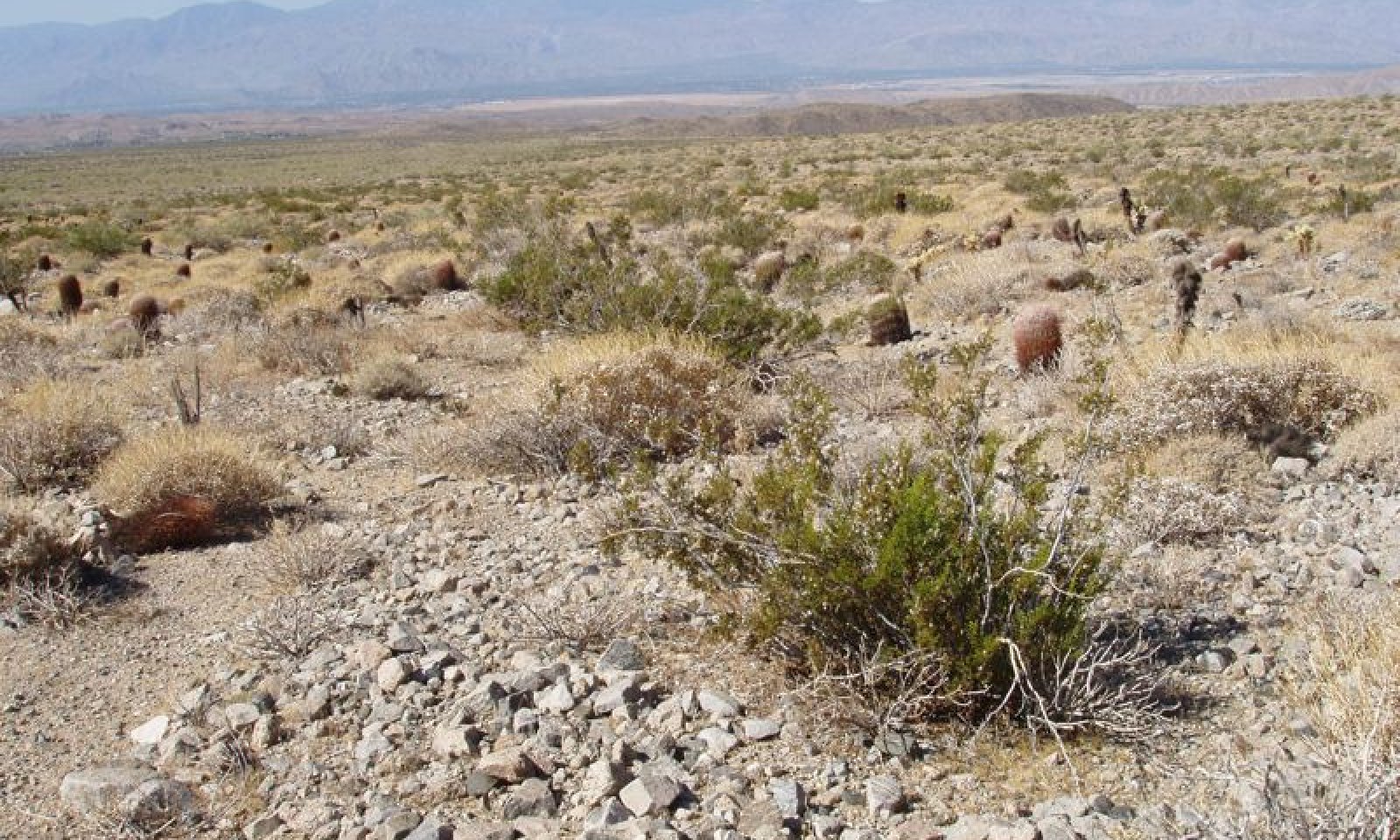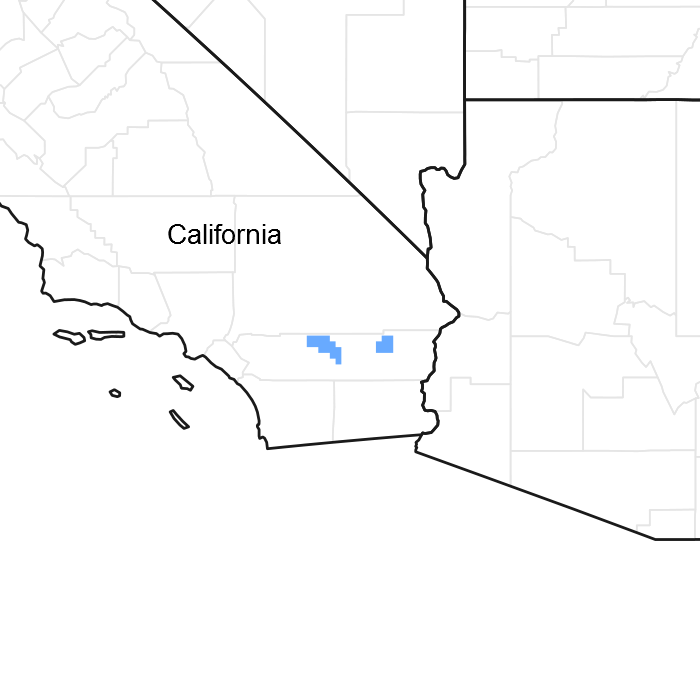

Natural Resources
Conservation Service
Ecological site R030XD039CA
Coarse Gravelly Fans
Last updated: 10/21/2024
Accessed: 03/17/2025
General information
Provisional. A provisional ecological site description has undergone quality control and quality assurance review. It contains a working state and transition model and enough information to identify the ecological site.

Figure 1. Mapped extent
Areas shown in blue indicate the maximum mapped extent of this ecological site. Other ecological sites likely occur within the highlighted areas. It is also possible for this ecological site to occur outside of highlighted areas if detailed soil survey has not been completed or recently updated.
MLRA notes
Major Land Resource Area (MLRA): 030X–Mojave Basin and Range
MLRA Description:
Major Land Resource Area (MLRA) 30, Mojave Desert, is found in southern California, southern Nevada, the extreme southwest corner of Utah and northwestern Arizona within the Basin and Range Province of the Intermontane Plateaus. The climate of the area is hot (primarily hyperthermic and thermic; however at higher elevations, generally above 5000 feet, mesic, cryic and frigid) and dry (aridic). Elevations range from below sea level to over 12,000 feet in the higher mountain areas found within the MLRA. Due to the extreme elevational range found within this MLRA, Land Resource Units (LRUs) were designated to group the MLRA into similar land units.
LRU Description:
This Land Resource Unit (designated by ‘XD’) is found on the eastern side of California. Elevations range from 400 to 2200 feet on average, but may be found up to 3600 feet on southern exposures. Precipitation ranges from 1 to 6 inches per year, but averages between 2-4 inches. This LRU is characterized primarily by the extreme aridity, hot temperatures, hyperthermic soil temperatures and low stature of widely spaced vegetation. Temperatures can reach over 110 degrees Fahrenheit for several weeks in July and August. Summer precipitation falls between July and September, ranging from 20-33% in the form of rain, and winter precipitation falls starting in November and ends between February and March, ranging from 56-70%, also mostly in the form of rain. Vegetation is primarily small, widely-spaced, low-producing creosote bush (Larrea tridentata), burrobush (Ambrosia dumosa), and brittlebush (Encelia farinosa).
Ecological Site Concept –
This ecological site occurs on fan aprons, alluvial fans, and fan remnants at elevations of 560 to 3610 feet. Soils are very deep, and typically have a high cover of surface gravels and cobbles, and have gravelly to extremely gravelly subsurface textures. This site typically has a very rare surface flooding regime. This ecological site occurs at the southern edge of the Mojave Desert (the Mojave Desert – Sonoran Desert or MLRA30 – 31 boundary). Thus, it represents a transition from a warm desert where winter precipitation is dominant, to a hot desert where summer precipitation is much more significant and frosts are rare.
Production reference value (RV) is 186 pounds per acre, and ranges from 120 to 318 pounds per acre depending on annual precipitation. The site is dominated by creosote bush (Larrea tridentata), and brittlebush (Encelia farinosa). A hyperthermic climate with low frost prevalence, deep gravelly soils, and a very rare surface flooding regime drives the vegetation community of this ecological site. Water rapidly permeates through coarse soils to deep soil layers in this hyperthermic climate. The deep-rooted, evergreen, creosote bush accesses deep water while extreme aridity at near surface depths, very rare flooding and low incidence of frost promotes dominance by the brittlebush.
The data in the following sections is from major (15% of map unit or greater) components only.
Classification relationships
Encelia farinosa Association of the Encelia farinosa shrubland alliance (Sawyer et al. 2009).
Associated sites
| R030XD003CA |
Hyperthermic Steep South Slopes This ecological site is found on adjacent south-facing mountain and hill slopes. Brittlebush (Encelia farinosa) is dominant. |
|---|---|
| R030XD006CA |
Abandoned Fan This ecological site occurs on adjacent fan aprons. Creosote bush (Larrea tridentata) is dominant. |
| R030XD040CA |
Hyperthermic Steep North Slopes This ecological site occurs on adjacent north-facing mountain slopes. Burrobush (Ambrosia dumosa) is dominant with a diverse secondary shrub community. |
| R030XY092NV |
DESERT PATINA This ecological site occurs on adjacent flat fan remnants with a desert pavement surface. Vegetation is very sparse, and dominated by creosote bush (Larrea tridentata). |
| R030XY128CA |
Broad, Gravelly, Hyperthermic Ephemeral Stream This ecological site occurs in medium-sized drainageways adjacent to this site. Desert lavender (Hyptis emoryi), creosote bush (Larrea tridentata) and burrobrush (Hymenoclea salsola) are dominant species. |
Similar sites
| R030XD041CA |
Channeled Warm Alluvial Fans This ecological site occurs on soils with lower rock fragment cover on the soil surface and volume in the soil profile. Burrobush (Ambrosia dumosa) is co-dominant with creosote bush (Larrea tridenta). |
|---|---|
| R030XD003CA |
Hyperthermic Steep South Slopes This ecological site occurs on mountain and hill slopes. Shrub diversity is lower, and brittlebush (Encelia farinosa) is strongly dominant. |
| R030XD006CA |
Abandoned Fan This ecological site occurs on fan aprons receiving much less additional moisture. Creosote bush (Larrea tridentata) is dominant. |
| R030XD015CA |
Hyper-Arid Fans This ecological site occurs on soils receiving less additional moisture. Brittlebush (Encelia farinosa) is trace if present, and burrobush (Ambrosia dumosa) is co-dominant with creosote bush (Larrea tridentata). |
Table 1. Dominant plant species
| Tree |
Not specified |
|---|---|
| Shrub |
(1) Larrea tridentata |
| Herbaceous |
Not specified |
Click on box and path labels to scroll to the respective text.

